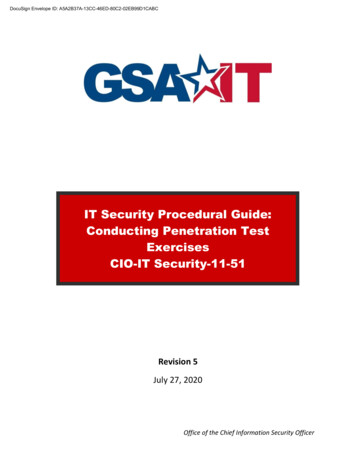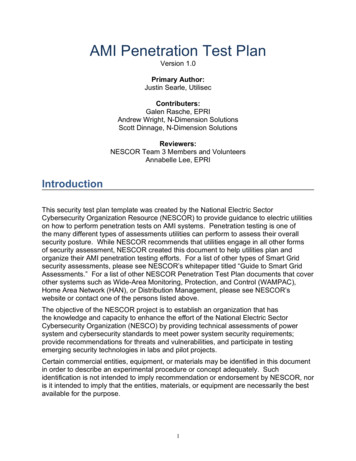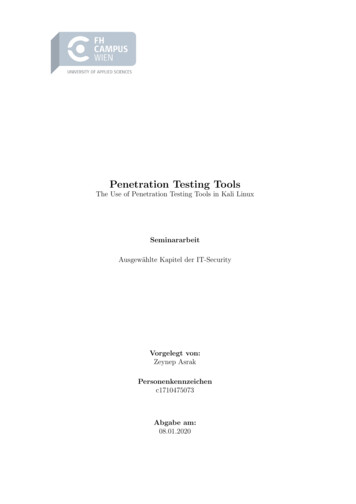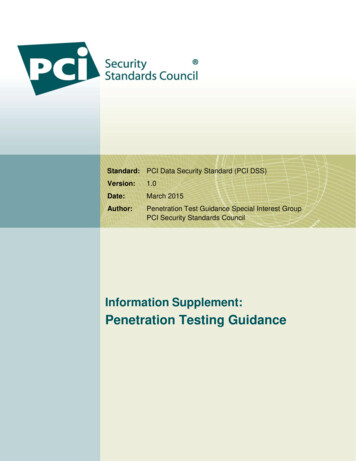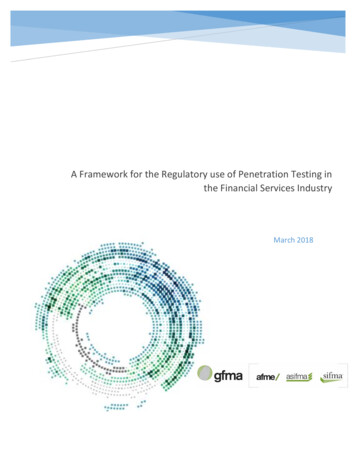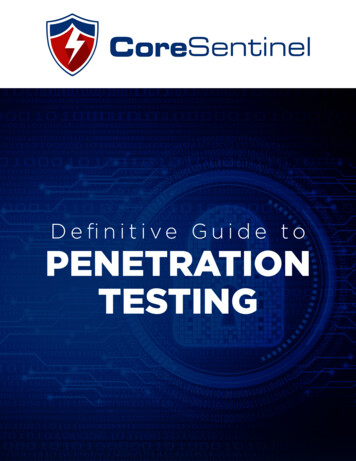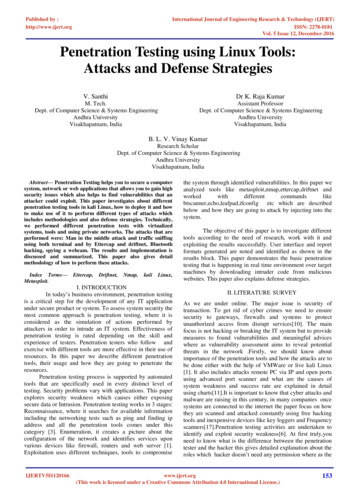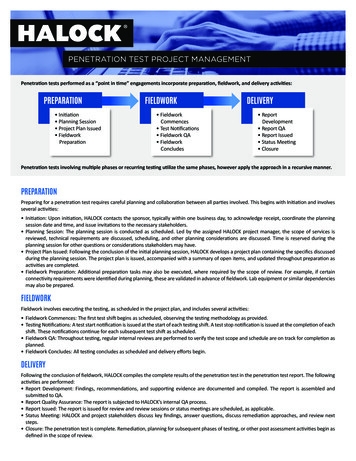
Transcription
PENETRATION TEST PROJECT MANAGEMENTPenetration tests performed as a “point in time” engagements incorporate preparation, fieldwork, and delivery activities:PREPARATION Initiation Planning Session Project Plan Issued FieldworkPreparationFIELDWORKDELIVERY FieldworkCommences Test Notifications Fieldwork QA FieldworkConcludes ReportDevelopment Report QA Report Issued Status Meeting ClosurePenetration tests involving multiple phases or recurring testing utilize the same phases, however apply the approach in a recursive manner.PREPARATIONPreparing for a penetration test requires careful planning and collaboration between all parties involved. This begins with Initiation and involvesseveral activities: Initiation: Upon initiation, HALOCK contacts the sponsor, typically within one business day, to acknowledge receipt, coordinate the planningsession date and time, and issue invitations to the necessary stakeholders. Planning Session: The planning session is conducted as scheduled. Led by the assigned HALOCK project manager, the scope of services isreviewed, technical requirements are discussed, scheduling, and other planning considerations are discussed. Time is reserved during theplanning session for other questions or considerations stakeholders may have. Project Plan Issued: Following the conclusion of the initial planning session, HALOCK develops a project plan containing the specifics discussedduring the planning session. The project plan is issued, accompanied with a summary of open items, and updated throughout preparation asactivities are completed. Fieldwork Preparation: Additional preparation tasks may also be executed, where required by the scope of review. For example, if certainconnectivity requirements were identified during planning, these are validated in advance of fieldwork. Lab equipment or similar dependenciesmay also be prepared.FIELDWORKFieldwork involves executing the testing, as scheduled in the project plan, and includes several activities: Fieldwork Commences: The first test shift begins as scheduled, observing the testing methodology as provided. Testing Notifications: A test start notification is issued at the start of each testing shift. A test stop notification is issued at the completion of eachshift. These notifications continue for each subsequent test shift as scheduled. Fieldwork QA: Throughout testing, regular internal reviews are performed to verify the test scope and schedule are on track for completion asplanned. Fieldwork Concludes: All testing concludes as scheduled and delivery efforts begin.DELIVERYFollowing the conclusion of fieldwork, HALOCK compiles the complete results of the penetration test in the penetration test report. The followingactivities are performed: Report Development: Findings, recommendations, and supporting evidence are documented and compiled. The report is assembled andsubmitted to QA. Report Quality Assurance: The report is subjected to HALOCK’s internal QA process. Report Issued: The report is issued for review and review sessions or status meetings are scheduled, as applicable. Status Meeting: HALOCK and project stakeholders discuss key findings, answer questions, discuss remediation approaches, and review nextsteps. Closure: The penetration test is complete. Remediation, planning for subsequent phases of testing, or other post assessment activities begin asdefined in the scope of review.
PENETRATION TEST METHODOLOGYWeb Application Penetration TestOVERVIEWFor critical web applications, an in-depth review is appropriate. As web applications vary greatly depending on the purpose, function,architecture, and code base, the specific approaches, testing perspectives, and utilized test profiles can vary.Multiple factors influence whether an attacker can gain access to the web application. There may be numerous methods to approach gainingaccess and exploit identified issues, but an attacker only needs to be successful in linking one path through the application.There are nearly 100 common application weaknesses. HALOCK’s approach to Web Application Penetration Testing provides a flexibleframework for comprehensively identifying and evaluating technical vulnerabilities. The following areas are considered and typicallyincorporated into the review, as they apply to the target web application:INFORMATION GATHERINGInitial information gathering is required to understand the application platform, technology, structure, and behavior. The following methodsmay be utilized, as applicable: Conduct search engine discovery and reconnaissance for information leakage Fingerprint web server Review webserver metafiles for information leakage Enumerate applications on webserver Review webpage comments and metadata for information leakage Identify application entry points Map execution paths through application Fingerprint web application framework Fingerprint web application Map network and application architectureCONFIGURATION AND DEPLOY MANAGEMENT TESTINGOnce the application has been mapped, additional configuration management checks assess the security of the host and application: Network/infrastructure configuration Application platform configuration File extensions handling for sensitive information Testing for the presence of old, backup and unreferenced files for sensitive information Infrastructure and application administrative interfaces HTTP methods HTTP strict transport security (HSTS) RIA cross domain policyIDENTITY MANAGEMENT TESTINGVerification, where appropriate, for account provisioning considerations, such as testing: Role definitions User registration process Account provisioning process (when self-registration is available) Account enumeration and guessable user accounts Weak or unenforced username policyAUTHENTICATION TESTINGTesting for authentication related weaknesses, such as: Credentials transported over an encrypted channel Default credentials
PENETRATION TEST METHODOLOGYWeb Application Penetration Test Weak lock out mechanisms Bypassing authentication schema Remember password functionality Browser cache weakness Weak password policy Weak security question/answer Weak password change or reset functionalities Weak authentication in alternative channels, where availableAUTHORIZATION TESTINGTesting to validate the security of authorization controls such as: Directory traversal/file include Bypassing authorization schema Privilege escalation Insecure direct object referencesSESSION MANAGEMENT TESTINGAn evaluation of session-related vulnerabilities involves testing: Bypassing session management schema Cookies attributes Session fixation Exposed session variables Cross-site request forgery (CSRF) Logout functionality Session timeout Session puzzlingDATA VALIDATION TESTINGTesting for data validation involves manipulation of input fields, query strings, hidden parameters, and related input methods. Reflected cross-site scripting (XSS) Stored cross-site scripting (XSS) HTTP verb tampering HTTP parameter pollution SQL injection LDAP injection ORM injection XML injection SSI injection XPath injection IMAP/SMTP injection Code injection (local and/or remote) Command injection Buffer overflow Heap overflow Stack overflow Format string Incubated vulnerabilities HTTP splitting/smuggling
PENETRATION TEST METHODOLOGYWeb Application Penetration TestTESTING FOR ERROR HANDLINGTesting error handling issues, as they relate to security, such as analysis of Error Codes and Stack Traces.TESTING FOR WEAK CRYPTOGRAPHYTesting to evaluate the effectiveness of encryption related protections, such as: Weak SSL/TLS ciphers Insufficient transport layer protection Sensitive information sent via unencrypted channelsBUSINESS LOGIC TESTINGTesting to determine if the flow or architecture of the application can be manipulated to gain access to sensitive information through flaws inbusiness logic, such as: Business logic data validation Ability to forge requests Integrity checks Process timing Number of times a function can be used Circumvention of workflows Defenses against application misuse Upload of unexpected file types Upload of malicious filesCLIENT-SIDE TESTINGAssessing vulnerabilities that commonalty affect the client side of the application session, such as: DOM based cross-site scripting (XSS) JavaScript execution HTML injection Client-side URL redirect CSS injection Client-side resource manipulation Cross-origin resource sharing (CORS) Cross-site flashing Clickjacking Web Socket insecurities Web messaging Local storage
PENETRATION TEST METHODOLOGYExternal Network Penetration TestOVERVIEWExternal penetration tests are different from automated vulnerability scans in that penetration tests are comprehensive, attempt to exploitidentified vulnerabilities, and follow manual practices used by hackers to take advantage of weak security systems or processes. Externalnetwork penetration testing, as detailed in the scope section earlier in this proposal, is performed remotely to simulate an external attack.HALOCK will attempt to exploit vulnerabilities identified on networks, systems, and responding services to gain access to sensitive informationassets using any appropriate means at their disposal. Testing is performed under controlled conditions to minimize the risk for system ornetwork disruption. The test provides comprehensive detail regarding security weaknesses that are present in the environment. HALOCK’sapproach to Penetration Testing locates target hosts and services, evaluates the security of those targets utilizing penetration test tools andmethods, attempts to gain access to the target hosts, and finally escalates privileges throughout the environment.Multiple factors influence whether an attacker can gain access to the environment from an external perspective. There may be numerousmethods to approach gaining access and exploit identified issues, but an attacker only needs to be successful in linking one path into theenvironment.Penetration testing is an iterative process. Each stage in the process may yield additional information that warrants revisiting earlier phases,equipped with new information. For example, passwords cracked resulting in the exploit of a domain controller later in the process may be fedback into earlier reconnaissance stages to determine if additional hosts can be accessed as a result.HALOCK’s approach to External Network Penetration Testing provide a flexible framework for comprehensively identifying and evaluatingtechnical vulnerabilities. The following phases are typically incorporated into the penetration test, as they apply to the target environment:RECONNAISSANCEAn attacker first must discover the target environment, beginning on the perimeter. To gain knowledge about the target environment anddevelop a list of potential targets, the attacker performs a series of initial reconnaissance activities. There are over 130,000 possible serviceson a single IP address that could potentially be assigned. To focus effort where most productive and minimize the impact of discovery,reconnaissance is typically performed in stages. The stages of reconnaissance begin broad, at the network, narrow to specific hosts, and finallyservices exposed within those hosts. Network Discovery: Each target ISP range included in the scope of review contains both assigned and unassigned IP addresses. To determinewhich of these IP addresses represent potential targets, network discovery is performed. Network Discovery consists of performing limitedport scanning, network mapping, ICMP requests, DNS queries, and similar probes. At this stage, comprehensive discovery is not necessary asa single response is sufficient to consider an IP address a potential target. Host Discovery: The subset of IP addresses that responded to discovery are then subjected to more comprehensive discovery to identify theservices exposed on a given IP address. This involves subjecting live IP addresses to additional port scanning. This port scanning sends up to1,000 requests to commonly utilized TCP and UDP ports. The number of ports probed varies based on network stability, response times, andother factors. Service Discovery: While TCP and UDP ports are typically associated to standard service, such as TCP80 for HTTP or UDP53 for DNS, theymay also be assigned to nonstandard port numbers. Service Discovery is leveraged to increase confidence in the host discovery results. TCP/IP stack fingerprinting, OS fingerprinting on redirected ports, NetBIOS queries, banner requests, and similar methods can provide an attackerwith details such as the specific software build version of a web hosting platform, if an SMTP service accepts relay, or if an FTP service isanonymous versus restricted to authenticated users.The results of these activities are parsed and compiled into the initial target list. This list serves as the basis for later activities and is updated asadditional information is obtained in later stages of the penetration test.TARGET PLANNINGUsing the results of the reconnaissance stage, a list of primary targets is selected. These “targets of interest” represent those the attackerperceives as potential high return entry points into the environment.The total number selected is defined by the scope of review and may include sampling. When sampling is utilized, targets are chosen based onperceived opportunity, with consideration of establishing a representative view of varying technologies, geographies, or other unique factors.
PENETRATION TEST METHODOLOGYExternal Network Penetration TestHosts initially excluded may later be reconsidered as targets, such as when an exploit involves the interaction between multiple hosts within theenvironment.VULNERABILITY ENUMERATIONThere are over 100,000 known (published) vulnerabilities documented on public sources such as CVE, Vendor References, Bugtraq, and otherrepositories. Many of these can be excluded using the results of the reconnaissance stage, such as when a given vulnerability check applies to atechnology not located in the environment. Further, an attacker is primarily focused on vulnerabilities with associated exploits that present anopportunity to either gain entry, or provide useful information that may help refine related exploits.Vulnerability enumeration involves the use of automated scanners configured to search for specific published vulnerabilities with knownassociated exploits. Manual vulnerability tests are performed to identify vulnerabilities scanners are not well suited to identify, such asunpublished (zero day) vulnerabilities, network layer weaknesses, vulnerabilities on services unique to the environment (such as custom webapplications), or when environments are observed to be unstable.Tests are run using minimal bandwidth and limit the number of hosts and services tested in parallel to minimize risk for disruption. Theenumeration and detection process runs in an iterative fashion for each target. All vulnerabilities detected are considered “potential”, andconsidered for the exploit phases.VULNERABILITY VALIDATIONAny vulnerabilities identified are viewed as potential at this stage. Additional testing is required to (a) confirm the vulnerability is valid or (b)confirm it is a false positive. The methods utilized vary greatly based on the vulnerability being subjected to validation. Validation may involvethe use of secondary purpose build scanning tools, manual tests to reproduce scanner results, or the development and execution of scriptedmethods when no known methods are available to validate.Vulnerabilities confirmed to be applicable to the service being tested are also subjected to single stage exploits, where such tests canbe performed under safe and controlled conditions. These tests are performed to attempt to establish an initial level of access, obtainconfiguration details, or yield other useful information to support exploit scenarios. The goal of this stage is to eliminate attack scenariosperceived as low value or otherwise nonproductive, identify hosts that may not be stable or suitable to targeting, and establish as many entrypoints as feasible.ATTACK PLANNINGAt this stage of the penetration test, the attacker has a much more detailed understanding of the components in the target environment, higherconfidence in which services are likely to present opportunity to gain access, if payloads are available or require development, which exploitscan and cannot be pursued under safe and controlled conditions, if expanded sampling is needed (such as when the initial targets yield littleopportunity for exploit), and which exploits are likely to yield the greatest potential for gaining access.EXPLOIT EXECUTIONThe primary goal for the exploit stage is to establish command and control, ideally with persistence, of one or more hosts within theenvironment, pursued under controlled conditions. The attacker pursues and documents each step of an exploit to demonstrate the stepsrequired to compromise the host or service being targeted. These exploits may include the use of publicly available tools and methods, or anapproach developed by the attacker in real time. The latter is common when zero-day vulnerabilities are identified and exploited.Each exploit targeting a host, service, network, application, or other asset is initially focused on compromising that specific asset, however mayalso yield opportunity to incorporate additional components in the environment. Defense evasion tactics are utilized to avoid or bypass controlsas observed in the environment. Host Exploits: The specific tests performed vary greatly based on the services detected, but typically leverage server misconfigurations,missing patches, or other weaknesses. Web Application Exploits: In the event web applications are detected during discovery, additional application layer tests may be performed.
PENETRATION TEST METHODOLOGYExternal Network Penetration TestThese tests are performed without authentication unless authenticated access is achieved as a direct result of an identified vulnerability.Tests are performed targeting most common or critical vulnerabilities as applicable, but may include other checks specific to the applicationfunction or technology. Comprehensive web application testing is not performed during a network penetration test, however any webapplication perceived as a potential entry point may be targeted to gain access. Network Exploits: Numerous protocols and network traffic traverse the public internet using clear text or otherwise insecure methods.HALOCK will perform tests to monitor, intercept, and record communications. The tests may vary based on the design of the infrastructureand types of network devices in place.Exploits perceived to provide opportunity to pivot laterally within a network, across networks, escalate privileges, or yield more information areadvanced to the next stage of the penetration test.PRIVILEGE ESCALATION AND LATERAL MOVEMENTWhen access to a given host or service is achieved, additional post exploit actions may allow an attacker to gain additional access, potentiallyallowing the attacker to penetrate the internal environment. These attacks involve both privilege escalation on the target host as well asattempts to escalate privileges laterally throughout the environment. This often involves leveraging information obtained at other stages of thepenetration tests. When attempts to access a host results in limited privileges, passwords obtained from other hosts compromised may be utilized to elevate toa more privileged role. Configuration weaknesses on a compromised host may allow the attacker to identify additional derivative vulnerabilities, each of which mayprovide additional opportunity to bypass security controls and elevate access. Compromised services running under a more privileged context than the attacker possesses may be leveraged as an intermediary to performactions on the behalf of the attacker. Integration considerations, such as centralized authentication or shared services, may allow an attacker to obtain sensitive information thatcould be used to access otherwise secured hosts. For example, compromising an edge network device that is also used as a VPN endpointmay provide an attacker an opportunity to subsequently compromise peer devices bridging remote networks.When a compromised host is determined to share a common internal (private) network, other hosts either not exploited or otherwise notpreviously visible become potential targets. Attempts to utilize the compromised host as an intermediary may allow an attacker to movelaterally throughout the environment. These exploit scenarios are explored as opportunity presents and may result in the identification ofadditional targets, derivative vulnerabilities, and exploits. Testing at this stage is highly iterative and often involves some or all the stageslisted above.Additional evidence, information, and examples are gathered to facilitate development of findings (which discuss impact) or exploitwalkthroughs (which depict impact).DATA EXFILTRATIONAmong the many threats security controls are designed to protect against, unauthorized access to protected information is key. A commontarget for attackers is this protected information. When access to a given host or service is achieved, searches are conducted to attempt tolocate sensitive information. Examples are cited where observed to demonstrate impact.While an actual attacker would likely attempt to exfiltrate large volumes of bulk data for offline review, this is not necessary during a controlledpenetration test. To validate if exfiltration is possible, the most common approach is to transfer a non-sensitive test file out of the organization(egress) to demonstrate the methods in which the observed live data could have been exfiltrated.
PENETRATION TEST METHODOLOGYInternal Network Penetration TestOVERVIEWInternal penetration tests are different from automated vulnerability scans in that penetration tests are more manual, attempt to exploitidentified vulnerabilities, and follow practices used by hackers to take advantage of weak security systems or processes. Internal networkpenetration testing, as detailed in the scope section earlier in this proposal, is performed remotely to simulate an attack performed from withinthe private network. This simulates conditions such as when an attacker is a malicious individual internal to the organization, when an externalattacker has achieved internal access by compromising an internal endpoint, or has achieved entry point through an external host.HALOCK will attempt to exploit vulnerabilities identified on networks, systems, and responding services to gain access to sensitive informationassets using any appropriate means at their disposal. Testing is performed under controlled conditions to minimize the risk for system ornetwork disruption. The test provides comprehensive detail regarding security weaknesses that are present in the environment. HALOCK’sapproach to Penetration Testing locates target hosts and services, evaluates the security of those targets utilizing penetration test tools andmethods, attempts to gain access to the target hosts, and finally escalates privileges throughout the environment.Multiple factors influence whether an attacker can elevate access to the environment while positioned from an internal perspective. There maybe numerous methods to approach gaining access and exploit identified issues, but an attacker only needs to be successful in linking one pathinto the environment.Penetration testing is an iterative process. Each stage in the process may yield additional information that warrants revisiting earlier phases,equipped with new information. For example, passwords cracked resulting in the exploit of a domain controller later in the process may be fedback into earlier reconnaissance stages to determine if additional hosts can be accessed as a result.HALOCK’s approach to Internal Network Penetration Testing provide a flexible framework for comprehensively identifying and evaluatingtechnical vulnerabilities across an enterprise network. The following phases are typically incorporated into the penetration test, as they apply tothe target environment:RECONNAISSANCEAn attacker first must discover the target environment. To gain knowledge about the target environment and develop a list of potential targets,the attacker performs a series of initial reconnaissance activities. When the scope of review defines multiple points of origin within an internalnetwork, discovery is repeated from these perspectives to better understand not only what an attacker may target, but from where they maydo so. There are over 130,000 possible services on a single IP address that could potentially be assigned. To focus effort where most productiveand minimize the impact of discovery, reconnaissance is typically performed in stages. The stages of reconnaissance begin broad, at thenetwork, narrow to specific hosts, and finally services exposed within those hosts. Network Discovery: Each target ISP range included in the scope of review contains both assigned and unassigned IP addresses. Todetermine which of these IP addresses represent potential targets, network discovery is performed. Network Discovery consists ofperforming limited port scanning, network mapping, ICMP requests, DNS queries, and similar probes. At this stage, comprehensivediscovery is not necessary as a single response is sufficient to consider an IP address a potential target. Host Discovery: The subset of IP addresses that responded to discovery are then subjected to more comprehensive discovery to identifythe services exposed on a given IP address. This involves subjecting live IP addresses to additional port scanning. This port scanning sendsup to 1,000 requests to commonly utilized TCP and UDP ports. The number of ports probed varies based on network stability, responsetimes, and other factors. Service Discovery: While TCP and UDP ports are typically associated to standard service, such as TCP80 for HTTP or UDP53 for DNS, theymay also be assigned to nonstandard port numbers. Service Discovery is leveraged to increase confidence in the host discovery results.TCP/IP stack fingerprinting, OS fingerprinting on redirected ports, NetBIOS queries, banner requests, and similar methods can provide anattacker with details such as the specific software build version of a web hosting platform, if an SMTP service accepts relay, or if an FTPservice is anonymous versus restricted to authenticated users.The results of these activities are parsed and compiled into the initial target list. This list serves as the basis for later activities and is updated asadditional information is obtained in later stages of the penetration test.
PENETRATION TEST METHODOLOGYInternal Network Penetration TestTARGET PLANNINGUsing the results of the reconnaissance stage, a list of primary targets is selected. These “targets of interest” represent those the attackerperceives as potential high return entry points into the environment.The total number selected is defined by the scope of review and may include sampling. When sampling is utilized, targets are chosen based onperceived opportunity, with consideration of establishing a representative view of varying technologies, geographies, or other unique factors.Hosts initially excluded may later be reconsidered as targets, such as when an exploit involves the interaction between multiple hosts within theenvironment.VULNERABILITY ENUMERATIONThere are over 100,000 known (published) vulnerabilities documented on public sources such as CVE, Vendor References, Bugtraq, and otherrepositories. Many of these can be excluded using the results of the reconnaissance stage, such as when a given vulnerability check applies to atechnology not located in the environment. Further, an attacker is primarily focused on vulnerabilities with associated exploits that present anopportunity to either gain entry, or provide useful information that may help refine related exploits.Vulnerability enumeration involves the use of automated scanners configured to search for specific published vulnerabilities with knownassociated exploits. Manual vulnerability tests are performed to identify vulnerabilities scanners are not well suited to identify, such asunpublished (zero day) vulnerabilities, network layer weaknesses, vulnerabilities on services unique to the environment (such as custom webapplications), or when environments are observed to be unstable.Tests are run using minimal bandwidth and limit the number of hosts and services tested in parallel to minimize risk for disruption. Theenumeration and detection process runs in an iterative fashion for each target. All vulnerabilities detected are considered “potential”, andconsidered for the exploit phases.VULNERABILITY VALIDATIONAny vulnerabilities identified are viewed as potential at this stage. Additional testing is required to (a) confirm the vulnerability is valid or (b)confirm it is a false positive. The methods utilized vary greatly based on the vulnerability being subjected to validation. Validation may involvethe use of secondary purpose build scanning tools, manual tests to reproduce scanner results, or the development and execution of scriptedmethods when no known methods are available to validate.Vulnerabilities confirmed to be applicable to the service being tested are also subjected to single stage exploits, where such tests canbe performed under safe and controlled conditions. These tests are performed to attempt to establish an initial level of access, obtainconfiguration details, or yield other useful information to support exploit scenarios. The goal of this stage is to eliminate attack scenariosperceived as low value o
Penetration tests involving multiple phases or recurring testing utilize the same phases, however apply the approach in a recursive manner. Penetration tests performed as a “point in time” engagements inc


